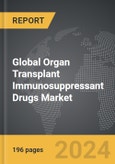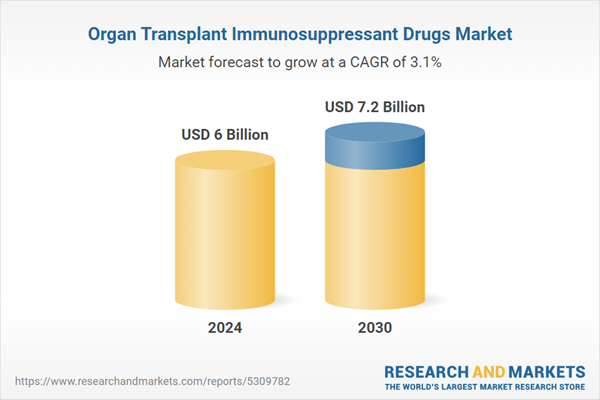Global Organ Transplant Immunosuppressant Drugs Market - Key Trends & Drivers Summarized
What Are Organ Transplant Immunosuppressant Drugs, and Why Are They Critical?
Organ transplant immunosuppressant drugs are vital medications given to patients who have undergone organ transplants to prevent the body from rejecting the new organ. These drugs work by suppressing the immune system's natural response to attack foreign tissues, which, in the case of transplants, could lead to graft failure and loss of the organ. Immunosuppressants are used across a range of transplant types, including kidney, liver, heart, and lung transplants, and they must be taken by recipients for the rest of their lives to ensure the long-term survival of the transplanted organ. Given the critical nature of organ transplants and the increasing number of people needing these procedures, immunosuppressant drugs play an indispensable role in modern medicine.How Are Technological Advancements Impacting Immunosuppressant Drugs?
The field of organ transplant immunosuppressant drugs has seen significant advancements, particularly in the development of more targeted and effective therapies. Innovations in biotechnology have led to the creation of drugs that specifically target the immune cells responsible for organ rejection, reducing the risk of side effects and improving the overall success rate of transplants. Monoclonal antibodies and biologics are two such advancements that offer more precise immunosuppression, allowing for better management of immune responses post-transplant. Additionally, advancements in personalized medicine and pharmacogenomics have enabled healthcare providers to tailor immunosuppressant therapies to individual patients, improving outcomes by minimizing the risk of rejection and drug toxicity. The ongoing research into immunomodulatory therapies and the development of next-generation immunosuppressants highlight the growing complexity and sophistication of treatment options available for transplant patients.Where Are Immunosuppressant Drugs Most Widely Used?
Immunosuppressant drugs are most commonly used in organ transplant procedures, with their application spanning a variety of transplant types. Kidney transplants represent the largest segment of the immunosuppressant drug market, followed by liver, heart, and lung transplants. As medical advances have made organ transplants more accessible and successful, the demand for these drugs has grown steadily. Immunosuppressants are also used in bone marrow transplants and in certain autoimmune diseases where controlling immune system activity is crucial. Hospitals and transplant centers worldwide rely on these drugs to manage the delicate balance between suppressing the immune system enough to prevent rejection while avoiding complications such as infections or cancer, which can arise from long-term immunosuppression.What Is Driving the Growth of the Immunosuppressant Drugs Market?
The growth in the organ transplant immunosuppressant drugs market is driven by several factors that reflect medical advancements and demographic trends. One of the primary drivers is the increasing number of organ transplants globally, fueled by rising rates of chronic diseases such as diabetes, heart disease, and liver failure, which result in the need for transplants. Another significant factor is the growing success rates of organ transplants due to advancements in surgical techniques and post-operative care, which have increased the demand for long-term immunosuppressant therapies. Additionally, the development of new and improved immunosuppressant drugs, including biologics and personalized medicine approaches, is boosting market growth by offering more effective and tailored treatments. The rising geriatric population, which is more prone to organ failure, further contributes to the expanding market. Finally, increased government initiatives and funding for organ transplant programs, combined with greater awareness about organ donation, are propelling the demand for immunosuppressant drugs across the globe.Report Scope
The report analyzes the Organ Transplant Immunosuppressant Drugs market, presented in terms of market value (USD). The analysis covers the key segments and geographic regions outlined below.- Segments: Drug Class (Calcineurin Inhibitors, Antibodies, Antiproliferative Agents, mTOR Inhibitor, Steroids); Therapeutic Area (Kidney Transplantation, Heart Transplantation, Liver Transplantation, Other Therapeutic Areas).
- Geographic Regions/Countries: World; United States; Canada; Japan; China; Europe (France; Germany; Italy; United Kingdom; and Rest of Europe); Asia-Pacific; Rest of World.
Key Insights:
- Market Growth: Understand the significant growth trajectory of the Calcineurin Inhibitors segment, which is expected to reach US$3.6 Billion by 2030 with a CAGR of 2.9%. The Antibodies segment is also set to grow at 4% CAGR over the analysis period.
- Regional Analysis: Gain insights into the U.S. market, valued at $1.6 Billion in 2024, and China, forecasted to grow at an impressive 3% CAGR to reach $1.2 Billion by 2030. Discover growth trends in other key regions, including Japan, Canada, Germany, and the Asia-Pacific.
Why You Should Buy This Report:
- Detailed Market Analysis: Access a thorough analysis of the Global Organ Transplant Immunosuppressant Drugs Market, covering all major geographic regions and market segments.
- Competitive Insights: Get an overview of the competitive landscape, including the market presence of major players across different geographies.
- Future Trends and Drivers: Understand the key trends and drivers shaping the future of the Global Organ Transplant Immunosuppressant Drugs Market.
- Actionable Insights: Benefit from actionable insights that can help you identify new revenue opportunities and make strategic business decisions.
Key Questions Answered:
- How is the Global Organ Transplant Immunosuppressant Drugs Market expected to evolve by 2030?
- What are the main drivers and restraints affecting the market?
- Which market segments will grow the most over the forecast period?
- How will market shares for different regions and segments change by 2030?
- Who are the leading players in the market, and what are their prospects?
Report Features:
- Comprehensive Market Data: Independent analysis of annual sales and market forecasts in US$ Million from 2024 to 2030.
- In-Depth Regional Analysis: Detailed insights into key markets, including the U.S., China, Japan, Canada, Europe, Asia-Pacific, Latin America, Middle East, and Africa.
- Company Profiles: Coverage of players such as AbbVie, Inc., Astellas Pharma US, Inc., Bristol-Myers Squibb Company, F. Hoffmann-La Roche AG, Novartis AG and more.
- Complimentary Updates: Receive free report updates for one year to keep you informed of the latest market developments.
Some of the 46 companies featured in this Organ Transplant Immunosuppressant Drugs market report include:
- AbbVie, Inc.
- Astellas Pharma US, Inc.
- Bristol-Myers Squibb Company
- F. Hoffmann-La Roche AG
- Novartis AG
- Pfizer, Inc.
- Sanofi SA
This edition integrates the latest global trade and economic shifts into comprehensive market analysis. Key updates include:
- Tariff and Trade Impact: Insights into global tariff negotiations across 180+ countries, with analysis of supply chain turbulence, sourcing disruptions, and geographic realignment. Special focus on 2025 as a pivotal year for trade tensions, including updated perspectives on the Trump-era tariffs.
- Adjusted Forecasts and Analytics: Revised global and regional market forecasts through 2030, incorporating tariff effects, economic uncertainty, and structural changes in globalization. Includes historical analysis from 2015 to 2023.
- Strategic Market Dynamics: Evaluation of revised market prospects, regional outlooks, and key economic indicators such as population and urbanization trends.
- Innovation & Technology Trends: Latest developments in product and process innovation, emerging technologies, and key industry drivers shaping the competitive landscape.
- Competitive Intelligence: Updated global market share estimates for 2025, competitive positioning of major players (Strong/Active/Niche/Trivial), and refined focus on leading global brands and core players.
- Expert Insight & Commentary: Strategic analysis from economists, trade experts, and domain specialists to contextualize market shifts and identify emerging opportunities.
Table of Contents
Companies Mentioned (Partial List)
A selection of companies mentioned in this report includes, but is not limited to:
- AbbVie, Inc.
- Astellas Pharma US, Inc.
- Bristol-Myers Squibb Company
- F. Hoffmann-La Roche AG
- Novartis AG
- Pfizer, Inc.
- Sanofi SA
Table Information
| Report Attribute | Details |
|---|---|
| No. of Pages | 196 |
| Published | December 2025 |
| Forecast Period | 2024 - 2030 |
| Estimated Market Value ( USD | $ 6 Billion |
| Forecasted Market Value ( USD | $ 7.2 Billion |
| Compound Annual Growth Rate | 3.1% |
| Regions Covered | Global |









